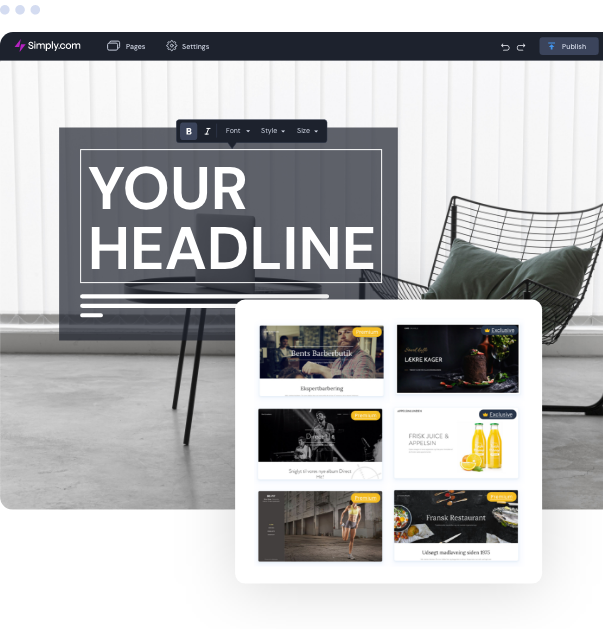Top Trends in Website Layout: What You Need to Know
Minimalism, dark mode, and mobile-first strategies are amongst the key motifs shaping modern-day design, each offering special advantages in individual engagement and performance. Additionally, the emphasis on access and inclusivity highlights the relevance of producing electronic environments that cater to all customers.
Minimalist Design Appearances
In the last few years, minimal layout aesthetic appeals have actually emerged as a dominant fad in website design, highlighting simpleness and capability. This method focuses on crucial content and removes unneeded components, thus improving customer experience. By focusing on clean lines, sufficient white area, and a minimal shade palette, minimalist styles assist in less complicated navigation and quicker load times, which are important in preserving customers' focus.
The effectiveness of minimalist style hinges on its capability to share messages plainly and straight. This quality cultivates an intuitive interface, allowing users to achieve their objectives with minimal disturbance. Typography plays a substantial role in minimal layout, as the option of typeface can evoke particular emotions and direct the individual's journey through the web content. Additionally, the calculated usage of visuals, such as high-grade photos or refined computer animations, can improve individual engagement without overwhelming the total visual.
As digital spaces proceed to develop, the minimal layout concept stays relevant, satisfying a diverse target market. Businesses adopting this pattern are frequently perceived as contemporary and user-centric, which can considerably affect brand assumption in a progressively competitive market. Inevitably, minimalist style aesthetic appeals offer a powerful remedy for efficient and enticing website experiences.
Dark Mode Appeal
Embracing an expanding fad amongst individuals, dark setting has actually gotten considerable popularity in website style and application user interfaces. This design approach includes a predominantly dark color palette, which not only boosts aesthetic charm but likewise decreases eye pressure, especially in low-light atmospheres. Users progressively appreciate the convenience that dark setting supplies, leading to much longer engagement times and an even more satisfying surfing experience.
The adoption of dark setting is additionally driven by its viewed benefits for battery life on OLED displays, where dark pixels take in much less power. This practical advantage, integrated with the elegant, contemporary look that dark motifs supply, has actually led lots of developers to include dark setting alternatives right into their jobs.
In addition, dark setting can produce a feeling of deepness and focus, attracting attention to crucial elements of a website or application. web design company singapore. Consequently, brands leveraging dark mode can boost user interaction and produce an unique identity in a congested marketplace. With the fad continuing to increase, incorporating dark mode into internet layouts is becoming not simply a choice however a standard expectation amongst individuals, making it necessary for programmers and designers alike to consider this aspect in their jobs
Interactive and Immersive Elements
Often, developers are integrating interactive and immersive components right into websites to improve customer interaction and create remarkable experiences. This fad reacts to the enhancing assumption from customers for even more dynamic and customized communications. By leveraging attributes such as computer animations, videos, and 3D graphics, internet sites can draw users in, fostering a much deeper connection with the material.
Interactive elements, such as tests, polls, and gamified experiences, urge site visitors to actively participate instead of passively consume info. This interaction not just maintains customers on the website much longer yet additionally enhances the probability of conversions. Additionally, immersive innovations like digital fact (VIRTUAL REALITY) and augmented truth (AR) provide one-of-a-kind possibilities for services to showcase products and services in a more engaging manner.
The unification of micro-interactions-- little, subtle animations that reply to individual activities-- also plays a critical role in enhancing functionality. These communications provide feedback, improve navigating, and develop a feeling of satisfaction upon completion of tasks. As the digital landscape proceeds to advance, using interactive and immersive elements will remain a considerable emphasis for designers aiming to produce appealing and efficient online experiences.
Mobile-First Strategy
As the frequency of mobile phones proceeds to rise, taking on a mobile-first approach has actually come to be essential for web designers aiming to maximize user experience. This technique emphasizes developing for smart phones before scaling up to bigger displays, ensuring that the core capability and web content come on one of the most generally utilized platform.
One of the primary benefits of a mobile-first technique is enhanced performance. By concentrating on mobile layout, web sites are streamlined, decreasing load times and enhancing navigating. This is especially important as individuals expect rapid and receptive experiences on their mobile phones and tablets.

Access and Inclusivity
In today's electronic landscape, making certain that internet sites come and inclusive see this website is not just an ideal method but a fundamental need for reaching a varied audience. As the internet proceeds to function as a key ways of communication and business, it is vital to acknowledge the diverse requirements of users, consisting of those with impairments.
To achieve real availability, web developers need to follow developed guidelines, such as the Internet Content Access Standards (WCAG) These guidelines stress the value of offering message alternatives for non-text material, making certain additional hints keyboard navigability, and keeping a logical web content structure. Inclusive layout practices prolong past compliance; they involve developing a customer experience that accommodates numerous abilities and choices.
Integrating attributes such as adjustable message dimensions, color comparison options, and screen viewers compatibility not only enhances use for people with handicaps yet likewise improves the experience for all customers. Ultimately, prioritizing availability and inclusivity fosters an extra fair electronic environment, encouraging broader involvement and interaction. As businesses progressively acknowledge the moral and economic imperatives of inclusivity, incorporating these principles into website style will certainly end up being an essential element of successful online techniques.
Final Thought
